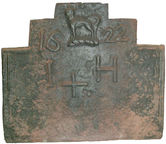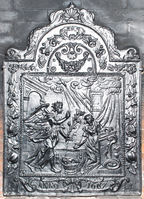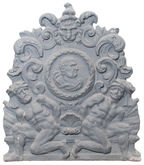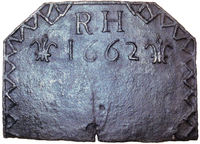-
206
Description: Rectangular with two-stepped top; double astragal edging on sides; top centre, stamp formed of a talbot statant guardant upon a wreath; date split either side of crest; initials below date, ‘+’ below letters.
Notes: The talbot crest is seen on other firebacks indicating a common source.
Copies of this fireback are known.
Inscription: 16 22 / I + H
- Decoration tags:
- stepped (shape)
- fillet (edging)
- simple stamps
- carved stamps
- individual numbers
- heraldic
- text
Manufactured: in 1622 in the Weald area of England.
Current location: St Mary's House, Bramber, West Sussex, England.
- Attached to series:
- Talbot crest series
- Stepped firebacks
-
21
Description: Rectangular central panel with bead edging all round, pictorial representation of the Annunciation by the Angel Gabriel to the Virgin Mary, the angel carries a lily, Mary kneels at a desk, between them is a basket, above them a dove descends from clouds amid sunbeams, to the left is an arch, in the centre a bed, and to the right a window and a canopy; above the panel is a bead-edged arch with a central scallop shell and a floral swag suspended from scrolls; arched rectangular shaped border with fillet edging, a cascade of leaves and fruit (inc. apples, grapes, pears and pomegranates) descending from a wreath, at the base two cartouches conjoined by a scallop shell and containing the inscription; on top a scallop shell between two dolphins.
Notes: A common fireback design originating in the Siegerland of north Germany and made for the Dutch market. A good clear casting. The illustration is copied from Virgil Solis, 'Biblische Figuren',1562.
Copies of this fireback are known.
Inscription: ANNO 1667
Manufactured: in 1667 in the Siegerland area of Germany.
Current location: Bateman's, Burwash, East Sussex, England.
Museum number: 761056 (part of the National Trust museum group)
Citation: Herskamp, W, 2007, Die Eiserne Bibel (Helios, Aachen).
- Attached to series:
- 'Dutch' Miscellaneous Firebacks
- New Testament firebacks
-
441
Description: Sub-rectangular; edged with a repeated length of helically-turned dowel (top and sides); apparently random arrangement of same piece of dowel repeated ten times, including a saltire and cross.
Notes: Apart from the Christian significance of the cross, the other arrangements of rope lengths may be apotropaic in their purpose, the double V being a possible invocation of the Virgin. The blemishes at the base are caused by the casting sand being disturbed by the pouring of the metal.
- Decoration tags:
- rectangular (shape)
- rope (edging)
- simple stamps
- apotropaic
- objects
Manufactured: in the 16th century in the Weald area of England.
Current location: Anne of Cleves House, Southover High Street, Lewes, East Sussex, England.
Museum number: LH000.799 (part of the Sussex Archaeological Society museum group)
Citation: Dawson, C., 1903, 'Sussex Iron Work and Pottery', Sussex Archaeological Collections, 46, pp. 1-54.
Citation: Gardner, J. S., 1898, 'Iron Casting in the Weald', Archaeologia, 56, 1, pp. 133-164.
- Attached to series:
- Rope design firebacks
-
452
Description: Circular wreathed medallion, bearing the right-facing head of a man in classical dress, carried by two naked, kneeling male figures seated on an elongated pedestal, between them a scallop shell; above the medallion a lion’s face surmounted by a flame; the medallion is surrounded by floral scrolls.
Notes: The wooden pattern would have had a circular aperture (the frame of which is just discernible) for the reception of the medallion; the same pattern was used to cast a fireback bearing the arms of George Worge, and the stamp of the profile was used on an accompanying fireplace side plate (no. 923).
- Decoration tags:
- baroque (shape)
- complex individual (edging)
- whole carved pattern
- pictorial
- humans
Manufactured: in the early- to mid-18th century probably at Robertsbridge Furnace, Salehurst in the Weald area of England.
Current location: Anne of Cleves House, Southover High Street, Lewes, East Sussex, England.
Museum number: LH000.998 (part of the Sussex Archaeological Society museum group)
Citation: Dawson, C., 1903, 'Sussex Iron Work and Pottery', Sussex Archaeological Collections, 46, pp. 1-54.
- Attached to series:
- Baroque series
-
860
Description: Canted rectangle; fillet edging (top and sides); top centre, initials, above date, between repeated fleur-de-lys stamp; from top corners to bottom corners, repeated V-shape pattern formed of stamped short fillets, with an L-shape inserted between the top two Vs on each side.
Notes: The fleurs de lys are of a distinctive style seen on a small group of firebacks.
Inscription: RH / 1662
- Decoration tags:
- rectangular with canted top corners (shape)
- fillet (edging)
- simple stamps
- carved stamps
- individual letters
- individual numbers
- heraldic
- text
- objects
Manufactured: in 1662 in the Forest of Dean area of England.
Current location: not known.
- Attached to series:
- Date & initials firebacks
- Newent area group




